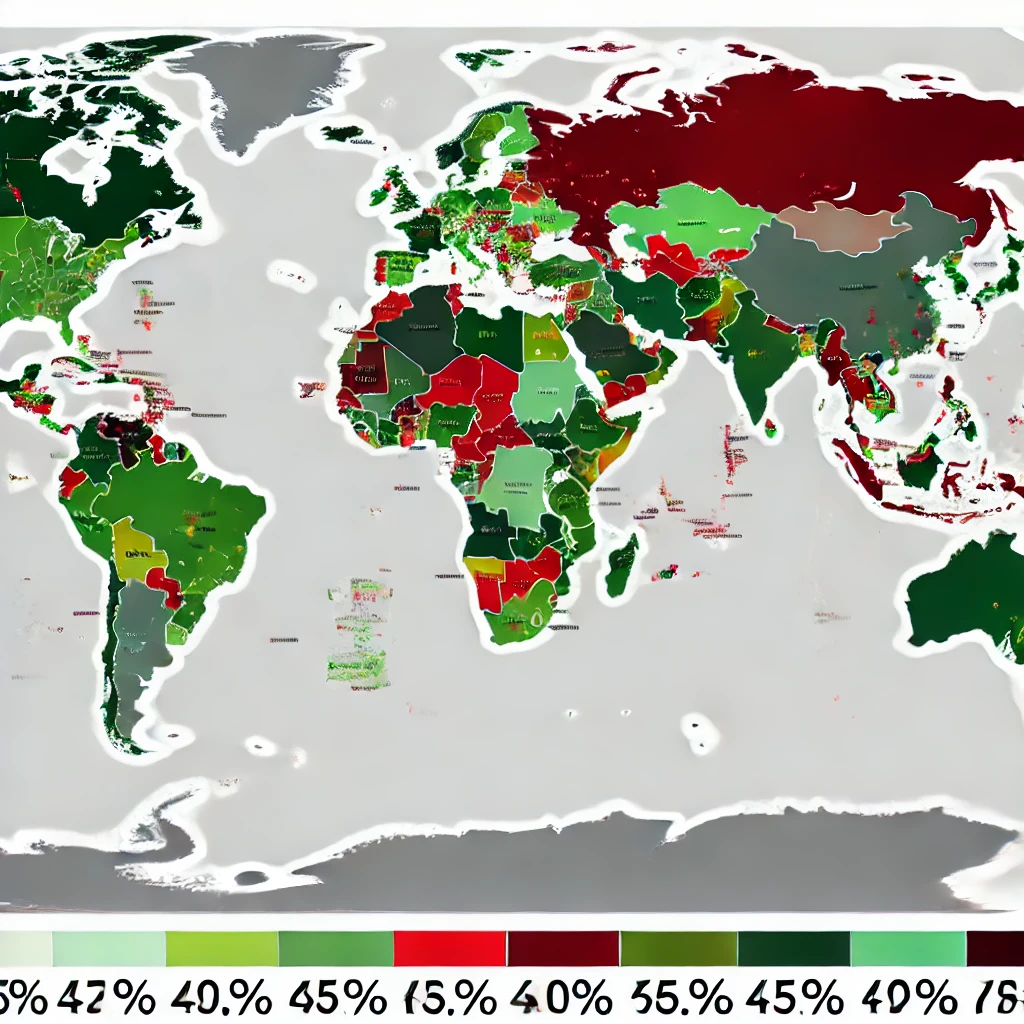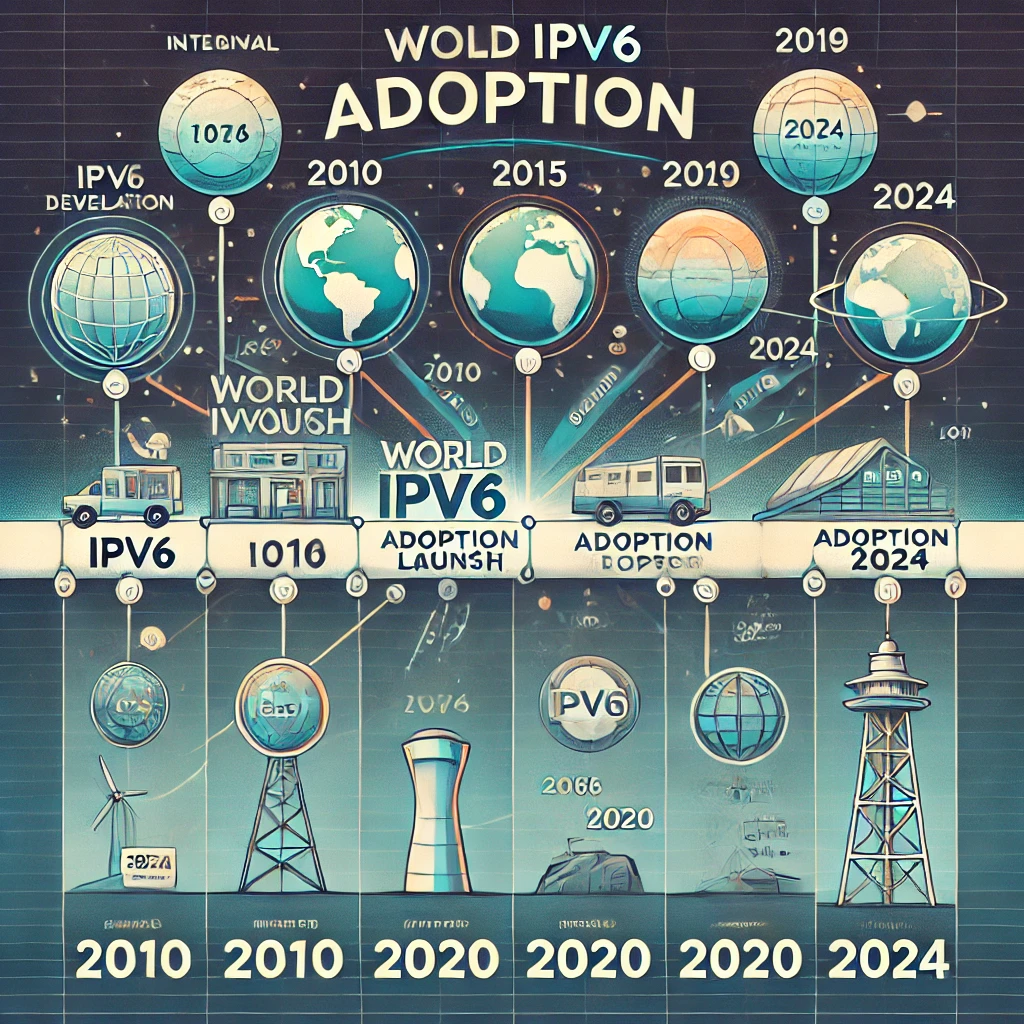IPv6 adoption in 2024
12 August 2024

The transition from IPv4 to IPv6 represents one of the most significant technological evolution in the history of the internet. 4.3 billion unique addresses were provided by IPv4 which was sufficient at its beginning. Due to the exponential growth of internet-connected devices, these addresses have been exhausted, causing the need to migrate to IPv6.
A 128-bit address space is capable of supporting 2128 or 340 282 366 920 938 463 463 374 607 431 768 211 456 addresses. IPv4 utilizes a 32-bit space, resulting in a total of 232 usable adresses. This means that for every one IPv4 address, there are approximately 7.9 x 1028 IPv6 addresses !
The adoption of IPv6 has been gradual and uneven across the globe. My intention in writing this article is to provide an analysis of the adoption of IPv6 in 2024.
Current situation
IPv6 adoption has seen significant progress in certain regions, yet remains stagnant in others. In 2024, the global IPv6 adoption rates have surpassed 50% in some countries, like France and Germany. France’s success can be attributed to aggressive policies and strong support from mobile network operators.
In contrast, the United States lags behind with a 45.75% adoption rate. The pandemic’s fluctuating deployment strategies are the cause of this surprising decline in velocity from previous years.
Regions like Africa and the Caribbean are still struggling with IPv6 adoption. Countries like Nigeria and Cuba have adoption rates of less than 1%. The primary causes of this are infrastructural challenges and political barriers.
Factors of IPv6 adoption
Several factors have driven the adoption of IPv6 in 2024.
-
Scarcity of IPv4 addresses: the exhaustion of IPv4 addresses has been playing a major part for IPv6 adoption. With the pool of available IPv4 addresses almost depleted, organizations and internet service providers are forced to transition to IPv6.
-
Growth of internet-connected devices: the proliferation of IoT devices, cloud computing, and mobile internet has necessitated a protocol capable of supporting an exponentially larger number of devices. The vast address space of IPv6 makes it ideally suited to meet this demand.
-
Improved network performance and security: IPv6 offers enhanced network performance, including more efficient routing, better end-to-end connectivity, and built-in security features like IPsec. These benefits have made IPv6 increasingly attractive to organizations looking to future-proof their networks.
Challenges
Despite its advantages, the transition to IPv6 is not without challenges.
-
Compatibility issues: one of the significant technological barriers to IPv6 adoption is the need for devices to support both IPv4 and IPv6. This is creating more complexity in network management. Dual-stacking, where networks run both protocols simultaneously, has become a typical solution that requires a lot of resources.
-
Security concerns: the transition to IPv6 introduces new security challenges. As highlighted by the NSA, networks that are new to IPv6 or those in the early phases of transition are particularly vulnerable due to immature configurations. Dual-stacked networks have a significant inherent security risk due to the increased attack surface.
-
Infrastructural limitations: in many developing regions, the lack of infrastructure and financial resources has significantly prevented IPv6 adoption. Without the necessary technology and the associated investments, these regions continue to rely on IPv4.
Geographic analysis
The adoption of IPv6 varies significantly across regions:
-
Europe: has been at the forefront of IPv6 adoption, with countries like Belgium and Germany showing high achievement levels. Belgium, in particular, has an amazing 74.93% adoption rate. This is driven by a strong will to modernize their internet infrastructure.
-
Asia: presents a mixed picture; India, Vietnam, and Taiwan are leading the adoption, while others countries lag behind. India’s rapid adoption can be linked to its booming tech industry and government initiatives aimed at promoting digital transformation.
-
North America: IPv6 adoption is primarily driven by mobile carriers. IPv6 is supported by 87% of deployments on these networks. However, overall adoption remains below expectations due to inconsistent deployment across different sectors and internet service providers.
-
Africa and the Caribbean: these regions show the lowest adoption rates, often below 1%. The lack of investment in modern internet infrastructure and political instability are major barriers to IPv6 deployment.

Perspectives
IPv6’s future lies in supporting the development of emerging technologies like AI and cloud computing. The demand for a robust and scalable internet protocol will only increase as these technologies become more and more common.
-
IPv6-only datacenters: one growing trend towards IPv6-only environments is emerging, particularly among tech giants like Google, Meta, and Microsoft. This shift simplifies integration with native IPv6 services and reduces reliance on IPv4, which is becoming increasingly scarce and costly.
-
Segment Routing over IPv6 (SRv6): is becoming more popular due to its flexible and efficient routing approach, particularly in 5G networks. With this method, internet service providers can address complex challenges in virtualized environments, opening up the way for more dynamic and scalable networks.
-
Economic incentives to help with transitioning: IPv4 addresses are becoming more expensive. So maintaining an IPv4-only infrastructure is increasingly costly. In 2024, Amazon Web Services have started charging for IPv4 addresses. Organizations are being forced to transition to IPv6 with such financial incentive.
Final thoughts
The shift from IPv4 to IPv6 is critical for sustaining the growth of our digital world. Despite progress, especially in Europe and Asia, the global adoption is still largely incomplete. Coordinating all actors with different agendas seems to be the first challenge. Especially when you consider that these actors are governments, international organizations and the internet service providers company. Implementing IPv6 massively in regions that are currently underdeveloped seems to be a very difficult task.